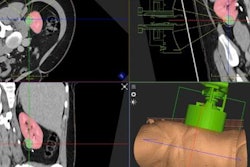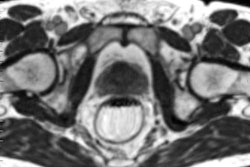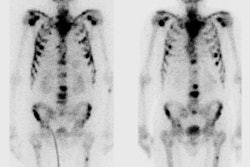
Focused ultrasound (FUS) is a developing noninvasive treatment technique that delivers ultrasonic energy to targets deep within tissue. During therapy, individual ultrasound beams pass harmlessly through adjacent tissue then converge to a focal point at the target, where they cause a profound therapeutic effect. FUS offers the potential to treat many different diseases -- from neurological disorders to cancers -- using a wide range of biomechanisms that occur at the focal point.
The Focused Ultrasound Foundation recently hosted the 5th International Symposium on Focused Ultrasound. In a dedicated briefing looking at recent clinical advances, leaders in the field shared some key results from this year's meeting.
Neurological applications
The first speaker, Jeff Elias from the University of Virginia, discussed the use of FUS for treating movement disorders. Elias highlighted new results, announced at the symposium and published in the New England Journal of Medicine, from a randomized trial of FUS thalamotomy for treating essential tremor, the most common movement disorder.
 Left to right: Paul Fishman, professor of neurology, pharmacology and neurobiology, University of Maryland School of Medicine; Jessica Foley, chief scientific officer, Focused Ultrasound Foundation; Jeff Elias, professor of neurological surgery, University of Virginia; Joo Ha Hwang, chief of gastroenterology, University of Washington; Pejman Ghanouni, assistant professor of radiology, Stanford University Medical Center; and Michael Gertner, CEO, Kona Medical. Image courtesy of medicalphysicsweb.
Left to right: Paul Fishman, professor of neurology, pharmacology and neurobiology, University of Maryland School of Medicine; Jessica Foley, chief scientific officer, Focused Ultrasound Foundation; Jeff Elias, professor of neurological surgery, University of Virginia; Joo Ha Hwang, chief of gastroenterology, University of Washington; Pejman Ghanouni, assistant professor of radiology, Stanford University Medical Center; and Michael Gertner, CEO, Kona Medical. Image courtesy of medicalphysicsweb.The study was performed with the Exablate Neuro, an MRI-guided FUS system that uses ultrasound transducers located on an MR-compatible helmet to enable treatment within an MR scanner, and MRI monitoring of therapy. The patients, who had moderate to severe tremor and had not responded to medication, experienced improved use of their hands following FUS, with around 50% tremor suppression overall.
These results led to FDA approval of the Exablate Neuro for treatment of essential tremor. "This is just the tip of the iceberg of what could be possible with this technology," Elias said. "We're really proud that the trial led to this approval."
The next step, he explained, was to extend this approach to patients with Parkinson's tremor. In a trial of 27 such patients with severe symptoms, a clear benefit was seen in those treated with FUS compared with a control group. A separate multicenter study is examining the use of FUS to treat dyskinesia -- another symptom of Parkinson's disease. Finally, Elias noted a trial has just started using FUS for subcortical epilepsy, in patients with severe seizures that don't respond to medication.
Looking ahead
Next, Paul Fishman from the University of Maryland took a look at possible future applications of FUS for treating brain disease. In particular, he discussed the use of FUS to improve delivery of drugs to the brain, a process currently hindered by the blood-brain barrier (BBB).
"There has been a huge explosion in the world of cellular and molecular biology and developing therapeutics," Fishman explained. "We have genetically engineered proteins and antibodies, gene therapy, and engineered therapeutic cells." But these therapeutics still need to be injected into the brain, and the bigger the structure, the more poorly they will spread through the brain.
Combining FUS with microbubbles allows controlled and safe BBB opening. Fishman cited a study showing that anticancer antibodies delivered in combination with FUS could shrink brain metastases in a rodent model. He also described the use of FUS-induced BBB opening to reduce the level of abnormal amyloid protein in an animal model of Alzheimer's disease -- an approach that he hopes will move into pilot clinical trials.
Studies have shown that even very large therapeutics such as stem cells can be introduced safely into the brain using FUS to open the BBB. However, delivering high enough levels to be effective is an ongoing challenge. As such, Fishman and colleagues are investigating magnetic targeting, in which cells loaded with iron oxide nanoparticles are magnetically steered into the brain. They have demonstrated a 10-fold increase in stem cell delivery using this approach.
"I'm looking forward to seeing delivery techniques catch up with the enormous progress that has been made in developing these therapies for human disease," Fishman said.
Oncology options
FUS in the brain generally involves ablation of an extremely small focal region. "In oncology, we take the same concept and use it to treat a larger volume," explained Joo Ha Hwang from the University of Washington. "The idea is to replace invasive therapy. We are able to destroy tissue noninvasively, typically through thermal mechanisms, but we're also exploring mechanical mechanisms by using histotripsy to completely destroy tissue without any cutting or scarring."
Hwang examined the current status of FUS for treatment of cancer. One evolving approach -- identified by the Cancer Moonshot as a key area of interest -- is to use FUS to enhance antitumor immune response. Potential mechanisms by which FUS can activate the immune system include upregulation of the immune system by cellular antigens and inflammation induced during thermal ablation or by cancer-specific antigens released during histotripsy, and upregulation of heat shock proteins during mild hyperthermia. "There is a lot of research going on," Hwang noted.
He described an example of a pancreatic cancer treated with FUS. After treatment, CT scans showed the tumor had been successfully ablated, but later scans also revealed that adjacent lymph nodes -- metastatic sites that had not been exposed to ultrasound -- exhibited no evidence of cancer. This is an example of the abscopal effect, in which treatment of the tumor somehow caused the body's own immune response to attack the metastases.
Hwang noted that many such anecdotal cases exist -- the task now is to discover how to control this effect and make it more effective. "Pancreatic cancer is a ripe target for FUS because there are so few effective therapies. But there is great potential in drug delivery, immune response, and ablation that we're very excited about," he said.
As for the here and now, Hwang mentioned FUS therapy for prostate cancer, where five companies are developing FUS devices and more than 55,000 patients have been treated worldwide. In addition, he noted, two ultrasound image-guided transrectal devices -- the Sonoblate 450 and Ablatherm -- have received U.S. Food and Drug Approval (FDA) approval in this past year for ablation of prostate tissue.
Bone and soft-tissue tumors
Continuing on the theme of cancer, Pejman Ghanouni from Stanford University Medical Center described the application of FUS for treating bone and soft-tissue tumors. "Bones are fantastic targets for this technology -- bone absorbs ultrasound readily and a little ultrasound energy results in high temperatures, increasing the safety margin and effectiveness," he explained.
Radiotherapy is commonly used to treat painful bone metastases, but does not work in every case. Patients treated using MR-guided FUS demonstrated a 64% response rate, a finding that led to its FDA approval as a standard treatment for bone metastases. Ghanouni described recent results from 130 FUS treatments performed after failed radiotherapy or as a first-line therapy. The researchers saw a 59% reduction in pain scores, with durable results one year later. In an ensuing study looking at tumor control in 50 metastatic bone lesions, they observed 92% tumor control at three-month follow-up.
FUS can also treat benign bone tumors, such as osteoid osteoma, which was previously treated with surgery or invasive radiofrequency ablation. In a recent study of MR-guided FUS of such tumors, 87% of 45 patients showed complete pain relief, durable at three years follow-up. MR-guided FUS is also being investigated for treating pain from arthritis, Ghanouni added.
"Another exciting application is treatment of soft-tissue tumors," Ghanouni said. He described the use of FUS on desmoid tumors, where current therapies don't work well. Sixty-six treatments performed to date, many with several years of follow-up, demonstrated the value of FUS. The approach is also being extended to soft-tissue sarcomas. "It's a very exciting time; we're able to meet an unmet need with this minimally invasive technology, and prove that it has significant efficacy with very few side effects," he concluded.
Tackling hypertension
Finally, Michael Gertner of Kona Medical, described the use of FUS for renal nerve ablation, which has been shown to lower blood pressure in patients with resistant hypertension. Kona Medical is developing a dedicated system for noninvasive ablation of renal nerves. The system has been used to treat more than 150 patients to date in three pilot studies, with a randomized sham controlled study now underway.
Previously, renal nerve ablation involved placing a catheter inside the renal artery. This means that only larger renal arteries can be treated and, as heat has to travel through the arterial wall to reach the nerves, can possibly damage the artery. "With external ablation, we can treat blood vessels down to 1 mm or 2 mm without any damage," Gertner explained. "One major advantage is that we can retreat patients, it may be preferential to treat these nerves in a fractionated method -- we're just starting to do this now."
Gertner noted that Kona Medical's device is very easy to use. "I can train any doctor to do this treatment -- if they're willing and motivated -- in about an hour," he said. "Hypertension is probably one of the biggest needs in cardiovascular medicine today."
© IOP Publishing Limited. Republished with permission from medicalphysicsweb, a community website covering fundamental research and emerging technologies in medical imaging and radiation therapy.



















